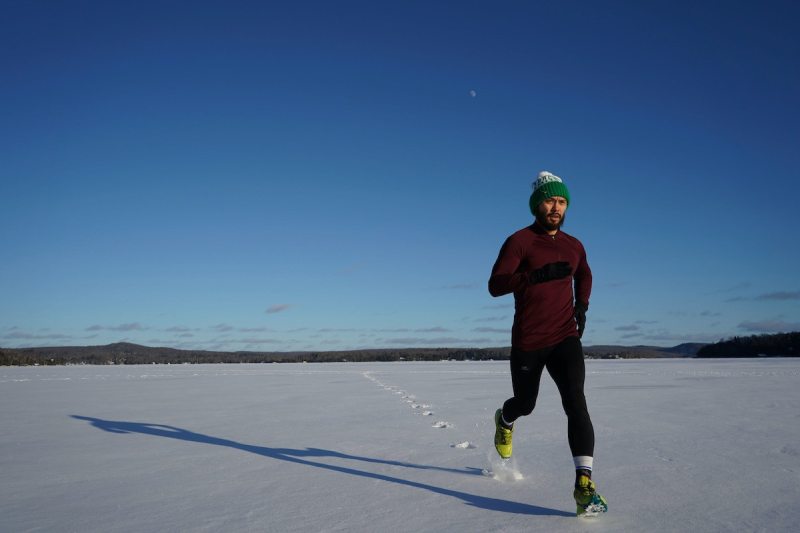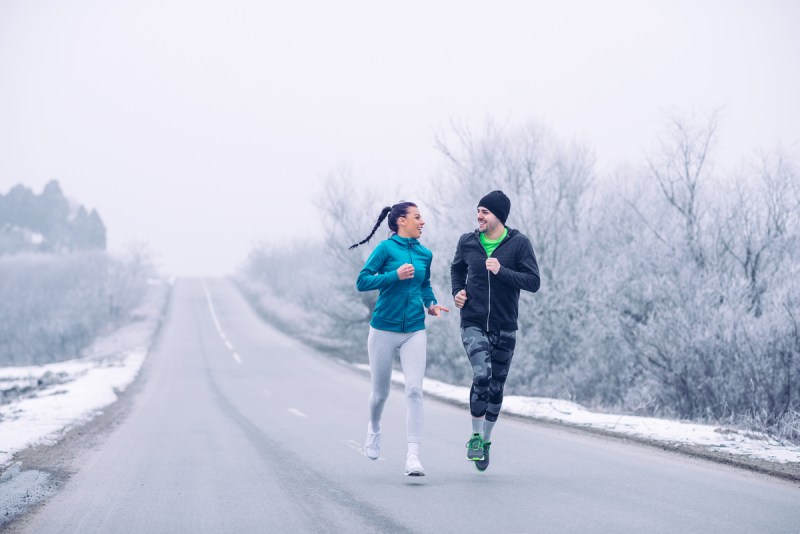Once the snowflakes start to fall, many runners take their pursuits inside on a treadmill. But have you ever considered the benefits of trail running in the winter? While there are some challenges, it can be a lot of fun if you’re adequately prepared. Here’s everything you need to know about winter trail running.
1. Don’t overdress, but be prepared

In colder months, the frigid, damp air can instantly send chills down your spine the moment you step outside. This might make it tempting to layer up, but you’ll quickly start to warm up once you start moving, sweating by the time you hit the first climb. You’ll then find yourself in a potentially dangerous situation once you start to cool down again on the way back down.
Try dressing for temperatures at least a few degrees warmer, and expect to be a little cold for the first few minutes of your run. Opt for tighter-fitting, moisture-wicking materials that cover your legs and arms but aren’t too thick. Dressing in layers that you can easily shed as you warm up can help, and I like to bring something extra like a lightweight down jacket, in case I want to stop for a few minutes on a summit or I run into trouble.
Keeping your feet dry can be close to impossible in slushy conditions, and blood tends to flow away from our extremities to our core when we’re cold. There are quite a few models of Gortex shoes on the market, but snow can easily get in from the top unless you’re also wearing gaiters, and even then they tend to underperform. Gortex socks, when paired with regular socks underneath, does the trick. However, you may need to size up your shoes by a half or even a full size to allow for the extra bulk and maintain proper circulation.
2. Use appropriate traction

Traction is crucial for trail running because the terrain often includes loose dirt, rocks, mud, sand, snow, and other slippery or uneven surfaces. Choosing and using the right traction can significantly improve performance and reduce the risk of injury.
There are some trail-specific traction options:
- Snow and ice: If you’re planning on a winter run, you’ll encounter a good amount of snow and ice unless you’re on a well-maintained road. Consider using microspikes or crampons over your trail running shoes to keep yourself from slipping around.
- Lug patterns: Trail running shoes are designed with wide and deep lug patterns, which provide grip on loose or slippery surfaces, such as muddy trails or gravel.
- Outsole material: Look for durable rubber compounds, like Vibram or similar, which offer excellent grip on both wet and dry surfaces.
- Rock plates: Some shoes include rock plates for additional protection on rugged terrain without compromising traction.
I’ve experimented with lightweight snowshoes designed for running, but have found them to be overkill for packed snow, as it’s difficult to actually “run” in deep powder. Whatever you choose, be sure that they are light weight and flexible enough and that they are appropriately sized for your specific shoes.
3. Slow it down and lower your mileage

Running in snowy and icy conditions engages muscles differently and can tax the body in different ways, so expect to cover fewer miles in the same time you would on dry ground. Drop your mileage to give your stabilizing muscles a chance to develop slowly to avoid injury, and focus more on time on feet than on distance.
4. Adjust your running technique

You will need to adjust your running technique. Landing lightly helps maintain traction without slipping, so avoid stomping. Use your forefoot, especially when on steep ascents. This will provide more grip than heel strikes. While on the run, be alert for any obstacles such as roots, rocks, uneven ground or ice, and slow down if the path becomes treacherous. Keep your strides short and controlled. Focusing on planting your feet directly underneath you will minimize slipping. Lastly, engage your core for improved balance.
5. Remember to eat and drink

It’s easy to forget to hydrate in cold weather because your body isn’t overheating in the same way it does in summer months, and eating can be difficult when wearing gloves. We’re often working even harder, though, when running on snowy terrain and burning more calories just to keep warm. The dry air can also catch up with you if you’re not staying on top of your hydration.
Make sure you drink water or an electrolyte-rich beverage a couple of hours before you start your run, but don’t drink too much or you might have to make an uncomfortable bathroom break. Wearing a hydration pack is a great way to keep water readily accessible, but if the temperature is below freezing, you’ll need to sip regularly to keep the tube clear of ice and cover the hose with insulation. To help with this, take small sips every 15 or 20 minutes, even if you don’t feel thirsty.
Eat a light snack that’s rich in simple carbohydrates about 30 minutes to an hour before your run. Pretzels and rice cakes are good options. Avoid high-fiber foods because they can cause discomfort during your run. Ultimately, your snack intake may take some experimentation. For runs longer than an hour, you’ll also want to carry energy-dense snacks like energy bars, dried fruits and nuts, or trail mix. Avoid high water-content foods like fresh fruit because those might freeze.
Ultimately, listen to your body.
When the weather starts getting chillier this year, consider taking the extra effort to run outdoors. The fresh air will do you good, and these tips will help you stay safe and warm as you venture out onto your favorite trails. With the proper preparation and mindfulness, winter running can be a rewarding addition to your training regimen.



